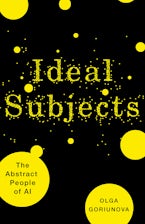Contents
Introduction: The Uses and Kinds of Subjects
Digital Subjects Operate at a Distance ~ Subject, Person, Self, and Subjectivity ~ Legal Fictive Person and Fictional Persona ~ Different Kinds and Uses of Abstraction ~ Ideal as Mathematical Projection, Inhabiting Abstractions Through Desire ~ The Body as a Reality Setting for Subjects ~ Some Shortcuts Through the Chapters
1. Subject at a Distance and the Politics of Knowing
What Kinds of Digital Subjects Are There? ~ Probability Distributions and Predicted Subjects as Patterns ~ Indexical Capacities of Data ~ An Index, Icon, or Diagram ~ Indexicality Comes from Elsewhere ~ Distance in the Digital Subject ~ The Modern Subject at a Distance from Oneself ~ Transcendental Subjects and Ideal Objects of Calculus ~ Asking About the Potential of Abstract Subjects ~ Subjects' Useful Uselessness: Lots of Abstractions ~ Conundrums
2. Ideals: Subjects Desire Abstractions
Correlating Patterns and Profiling the Ideal Subject ~ Ideal as Abstraction: How to Desire a Top Percentile ~ Becoming Oneself: Desire to Be Known by Computation ~ Recognizability: Artificial Intelligence as Subjective and Objective Truth-Teller ~ Bayesian Prediction in the Quest for Truths ~ The Hegelian Mutual Realization of Subject and World ~ Gripping Subjects
3. Struggles for Realities
Singular Identity, Ground Truthing, Making the "Really True" ~ Nature Versus Biometrics: Data-Stitching and Aligning ~ Shaping Artificial Intelligence to Orchestrate a "Real World" ~ The Shifting Sands of New Realities
Acknowledgments
Notes
Index

